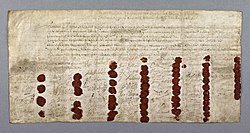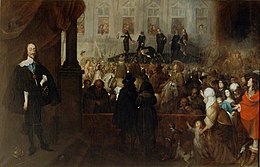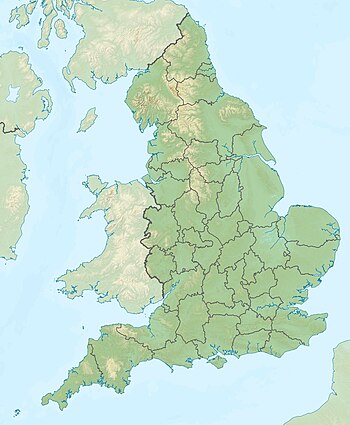John Hewson (regicide)
John Hewson | |
|---|---|
 Death warrant of Charles I; Hewson's signature is bottom of the fourth column from the left | |
| Committee of Safety | |
| In office October 1659 – December 1659 | |
| Member of Parliament for Guildford | |
| In office September 1656 – January 1658 | |
| Member of Parliament for County Dublin | |
| In office September 1654 – January 1655 | |
| Nominated to Barebones Parliament as MP for Ireland | |
| In office July 1653 – December 1653 | |
| Governor of Dublin, Ireland | |
| In office September 1649 – October 1656 | |
| Personal details | |
| Born | Unknown [a] London |
| Died | 1662 Amsterdam, possibly Rouen |
| Spouse(s) | Twice married, unknown |
| Children | Possibly three sons |
| Occupation | Shoemaker, soldier, politician and religious radical |
| Military service | |
| Allegiance | Parliamentarian |
| Years of service | 1642–1659 |
| Rank | Colonel |
| Battles/wars | |
Colonel John Hewson, also spelt Hughson (died 1662), was a shoemaker from London and religious Independent who fought for Parliament and the Commonwealth in the Wars of the Three Kingdoms, reaching the rank of colonel. Considered one of Oliver Cromwell's most reliable supporters within the New Model Army, his unit played a prominent part in Pride's Purge of December 1648. Hewson signed the death warrant for the Execution of Charles I in January 1649, for which he reportedly sourced the headsman, while soldiers from his regiment provided security.
During the 1649 to 1660 Interregnum, he served as Governor of Dublin and MP for County Dublin until 1656. He then returned to England and was MP for Guildford before being elevated to Cromwell's Other House in 1658. As one of the surviving Regicides of Charles I, he was exempted from the Indemnity and Oblivion Act after the 1660 Stuart Restoration. He went into exile in the Dutch Republic, and is thought to have died in Amsterdam in 1662.
Personal details
Very little is known of Hewson's life prior to 1642, other than that he worked as a shoemaker in Westminster during the late 1620s and 1630s.[2] [b] In February 1628, he is recorded as having sold eight pairs of shoes to the Massachusetts Bay Company; [4] this suggests he was born prior to 1604, since doing so required him to be a freeman of the Worshipful Company of Cordwainers, and at least 24 years old.[1]
Hewson himself later testified he had lived as a "child of wrath"[c] in a "wicked and profane family" in London, before being converted through the influence of a godly preacher.[5] He was later accused of being an Anabaptist, a sect viewed as radical revolutionaries, and in consequence persecuted by Catholics and mainstream Protestants alike.[6]
Hewson was married twice; his first wife died in Dublin in January 1652, and he quickly remarried.[7] The names of his partners, and whether either marriage produced children, are unknown, [8] although one source claims he had three unrecorded "Anabaptist" sons.[9] [d]
First English Civil War
Prior to the outbreak of the First English Civil War in August 1642, Hewson probably served in the Westminster Trained Bands, [e] which fought at Turnham Green. He subsequently joined the Parliamentarian field army,[f] and is thought to be the "John Huson" listed in November 1642 as a captain in the Earl of Essex Regiment.[5] At some point in 1643, he transferred to the army of the Eastern Association, commanded by the Earl of Manchester, and in March 1644 was appointed Lieutenant colonel of a new infantry regiment raised by John Pickering.[5] This unit fought at Marston Moor in July, then Second Newbury in October.[10]
Pickering's Regiment was incorporated into the New Model Army in April 1645 as one of its twelve authorised infantry formations, with Hewson as Lieutenant Colonel. Like Hewson, Pickering was a religious Independent with strong Anabaptist sympathies, while other officers included Major John Jubbes, a Leveller who resigned his commission in 1647, and Daniel Axtell, a Baptist and future regicide.[11] Their appointments had to be approved by Parliament, whose moderate Presbyterian majority viewed the growth of religious and political radicalism in the army with considerable unease. The House of Lords originally replaced Pickering and all of his company commanders, including Hewson, with officers from another regiment, before pressure from the House of Commons led them to approve the original list by one vote.[12]
Seen as particularly close to Oliver Cromwell, in June 1645 Pickering's was described as one of the 'chiefest praying and preaching regiments in the army'.[13] Hewson fought at Naseby in June 1645, then took part in the offensive against Royalist strongholds in South West England, including Sherborne Castle, Lacock Abbey, Bridgwater, Bristol and Basing House.[14] While besieging Exeter in November, Pickering died at Ottery St Mary and was replaced by Hewson as colonel, with Axtell as his deputy.[10] The regiment then joined the forces besieging the Royalist wartime capital of Oxford, whose surrender in June 1646 brought the First Civil War to an end. While stationed in the area, Hewson confirmed his reputation as a religious radical by illegally preaching in a local church, having first denounced its minister as an agent of the Antichrist.[15]
Second English Civil War and Cromwellian Conquest of Ireland
Despite victory in the First Civil War, the period that followed saw increasing conflict between the moderate majority in Parliament, and more radical elements within the New Model Army. By early 1647, its soldiers were owed more than £300,000 in wages, an enormous sum for the period, while Parliament was struggling with a shattered economy, an outbreak of the bubonic plague, and the refusal of Charles I to agree a peace settlement. Hewson acted as one of the army's representatives in negotiations with Parliament over their arrears, and in November 1647 Sir Thomas Fairfax ordered his regiment into London to seize money for paying the troops.[16]

When the Second English Civil War began in April 1648, Hewson helped suppress the rebellion in Kent, including the storming of Maidstone, where he was commended for his bravery.[16] The renewed fighting convinced Cromwell and others that Charles must be removed, and Hewson played a prominent part in bringing this about. His regiment supported Pride's Purge of December 1648, where MPs who opposed putting the king on trial were forcibly excluded or arrested. In January 1649, he served on the court that approved the Execution of Charles I, signed the death warrant and reportedly sourced the headsman, while soldiers from his regiment under Daniel Axtell provided security during the trial and execution.[10]
Despite his religious radicalism, Hewson was an authoritarian in matters of army discipline. When 300 men from his regiment refused in May 1649 to serve in the proposed Cromwellian Conquest of Ireland, they were swiftly dismissed, after which Hewson helped Cromwell crush the Banbury mutiny.[17] In late August, he arrived in Ireland as part of Cromwell's expeditionary force and was present at the Siege of Drogheda, where he allegedly set fire to a church containing nearly 100 Irish and English Royalist refugees.[18] Shortly afterwards, Hewson replaced Michael Jones as Governor of Dublin, then participated in the relief of Arklow and the Siege of Kilkenny in March 1650, where he lost an eye.[10]
The Interregnum and death
After the capture of Clonmel in May 1650, Cromwell returned to England, leaving Henry Ireton in charge of reducing the remaining pockets of organised Irish resistance.[19] Hewson continued as Governor of Dublin, and joined the Gathered church founded there by John Rogers, a leading Fifth Monarchist preacher,[10] putting him at odds with the majority of the Dublin Castle administration, who were either Presbyterians or members of the mainstream Protestant Church of Ireland. Recalled to London for consultations in 1652, he was nominated MP for Ireland in the 1653 Barebones Parliament; unlike many of his army colleagues, he supported its dissolution, and backed Cromwell's appointment as Lord Protector, albeit allegedly with great reluctance.[10]
Returning to Ireland, Hewson was elected MP for County Dublin in the First Protectorate Parliament of 1654, but later fell out with Henry Cromwell, the new Lord Lieutenant of Ireland. Ordered back to England in 1656, he represented Guildford in the Second Protectorate Parliament, in which role he opposed Parliamentary moves to offer Cromwell the crown. In 1658, he was created Lord Hewson and took his place in Cromwell's Other House, a body equivalent to the House of Lords abolished in 1649. The Puritan Earl of Warwick reportedly refused to attend the House in protest at the elevation of a man with Hewson's low social origins.[20]
Cromwell died in September 1658 and was succeeded as Lord Protector by his eldest son Richard. He proved incapable of controlling the competing factions within the New Model and Parliament, and resigned in May 1659, bringing the Protectorate to an end.[21] The Rump Parliament dismissed in 1653 was reseated, and Hewson was appointed commander of the infantry in Ireland, but was back in London in October as a member of the Committee of Safety, set up by the army to assert its authority over Parliament. In December, the Council ordered Hewson to suppress demonstrations in London demanding a free Parliament, during which several people were killed. This destroyed their authority, and Hewson was cashiered, although he escaped further punishment.[10]
By April 1660, the Stuart Restoration was imminent which meant regicides like Hewson were liable to arrest and execution; he escaped to Amsterdam in May, where he is thought to have died in 1662.[20] However, this is not known for certain, while other sources claim he died in Rouen in 1663.[10]
Notes
- ^ Probably before 1604, since Hewson was working as an independent shoemaker in 1628, which required him to be at least 24 years old [1]
- ^ This is generally agreed by historians, despite claims by a 19th century descendant that he came from a "good family" of landed gentry in Tenterden, Kent [3]
- ^ A Biblical term then commonly used to mean "evil doers"
- ^ Births were normally registered when the child was baptised, but since Anabaptists believed in adult baptism, these records would not have existed
- ^ A part-time militia, membership was compulsory for householders like Hewson
- ^ The Trained Bands were technically only required to defend London, while members of the field army could serve anywhere
References
- ^ a b Wallis 2019, pp. 247–281.
- ^ Noble 1798, p. 352.
- ^ Anonymous 1906, p. 429.
- ^ Firth 1891, p. 311.
- ^ a b c Durston 2004.
- ^ Preheim, Rick (19 June 2004). "Atonement For 2 Centuries Of Persecution". Washington Post. Retrieved 6 October 2022.
- ^ Anonymous 1906, p. 431.
- ^ Anonymous 1906, p. 432.
- ^ Noble 1798, p. 354.
- ^ a b c d e f g h Roberts 2004.
- ^ Roberts, Stephen.
- ^ Wanklyn 2014, pp. 117–118.
- ^ Childs 2022, p. 207.
- ^ Childs 2022, p. 208.
- ^ Gentles 1992, p. 102.
- ^ a b Gardiner 1905, p. 24.
- ^ Royle 2004, pp. 510–511.
- ^ Wheeler 1999, p. 88.
- ^ Royle 2004, p. 549.
- ^ a b Noble 1798, p. 421.
- ^ Royle 2004, p. 678.
Sources
- Anonymous (1906). "Colonel John Hewson, the Cromwellian". The Journal of the Royal Society of Antiquaries of Ireland. 36 (4): 429–432. JSTOR 25507569.
- Childs, Jesse (2022). The Siege of Loyalty House: A new history of the English Civil War. Bodley House. ISBN 978-1847923721.
- Durston, Christopher (2004). "Hewson, John, appointed Lord Hewson under the Protectorate(fl. 1630–1660)". Oxford Dictionary of National Biography (online ed.). Oxford University Press. doi:10.1093/ref:odnb/13157. (Subscription or UK public library membership required.)
- Firth, Charles (1891). . Dictionary of National Biography. Vol. 26. pp. 311–312.
{{cite encyclopedia}}: CS1 maint: date and year (link) - Gardiner, Samuel Rawson (1905). History of the Great Civil War, Volume IV. Longmans, Green & Co.
- Gentles, Ian (1992). The New Model Army in England, Ireland and Scotland, 1645-1653. Blackwell. ISBN 978-0631158691.
- Noble, Mark (1798). Lives of the English Regicides, Volume 1. G. G. J. and J. Robinson.
- Roberts, Stephen, K. "The Cromwell Association Online Directory of Parliamentarian Army Officers". British History Online; Surnames beginning "A". Retrieved 16 December 2022.
- Roberts, Keith (2004). "Pickering, John (bap. 1615, d. 1645)". Oxford Dictionary of National Biography (online ed.). Oxford University Press. doi:10.1093/ref:odnb/22210. (Subscription or UK public library membership required.)
- Royle, Trevor (2004). Civil War: The Wars of the Three Kingdoms 1638–1660 (2006 ed.). Abacus. ISBN 978-0-349-11564-1.
- Wanklyn, Malcolm (2014). "Choosing Officers for the New Model Army, February to April 1645". Journal of the Society for Army Historical Research. 92 (370): 109–125. JSTOR 44232556.
- Wallis, Patrick (2019). Apprenticeship in England in Apprenticeship in Early Modern Europe. CUP. ISBN 978-1108690188.
- Wheeler, James Scott (1999). Cromwell in Ireland. Gill & Macmillan Ltd. ISBN 978-0-7171-2884-6.
- 1662 deaths
- Regicides of Charles I
- English army officers
- English MPs 1653 (Barebones)
- English MPs 1654–1655
- English MPs 1656–1658
- Members of Cromwell's Other House
- Members of the Parliament of Ireland (pre-1801) for County Dublin constituencies
- Members of Parliament for Guildford
- Parliamentarian military personnel of the English Civil War

